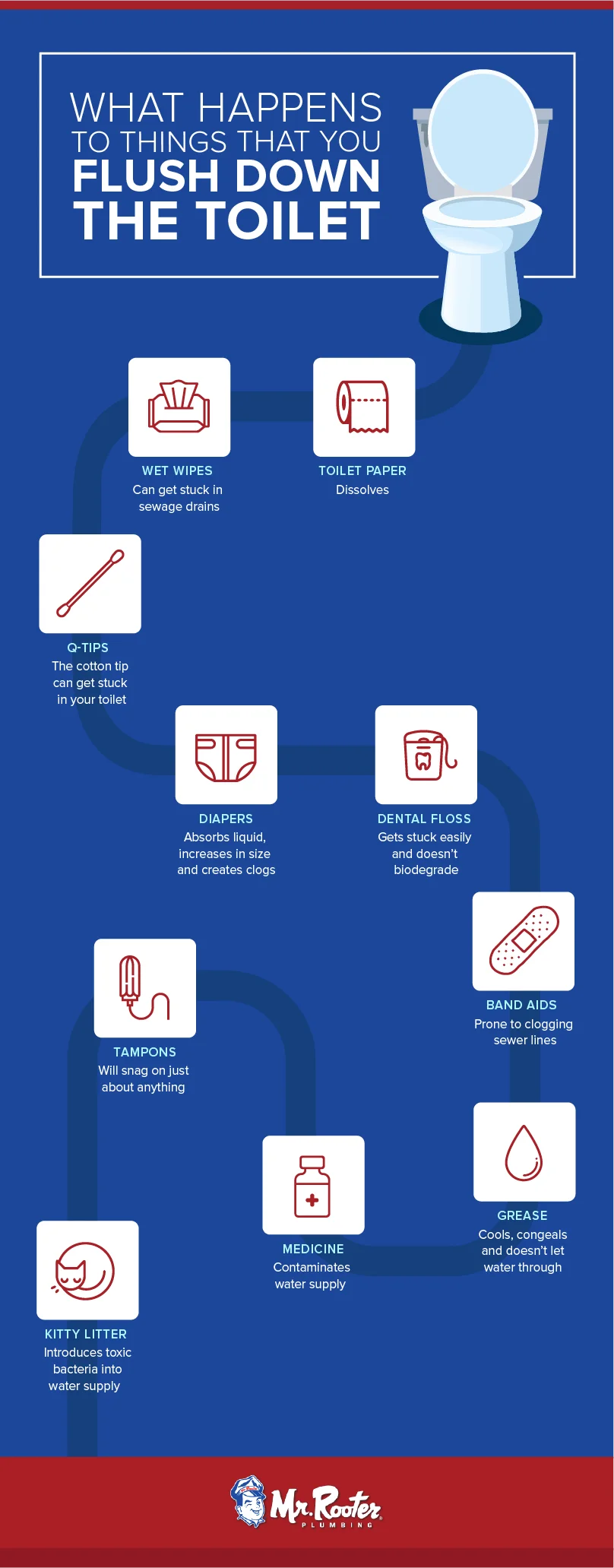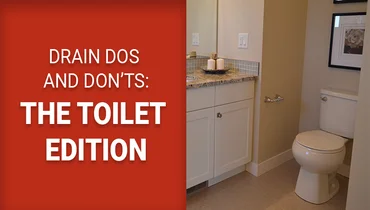
You’ll use your toilet about 2,500 times this year, and that means you’re likely to experience a few clogs along the way. Since we’ve recently passed “World Toilet Day,” we think it’s appropriate to consider the commode and all the things that shouldn’t go down it, but do.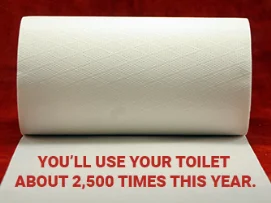
The toilet is a sacred space where you need to feel safe and comfortable. Keep it that way by limiting clogs and sewer problems that can ruin a room and cost a pretty penny to fix. Let’s look at some of the biggest issues and learn what not to flush.
Why Your Toilet Clogs
American toilets tend to clog more than those in other countries because we have a specific design for seating, trapping and flushing. The standard U.S. toilet will rely on a siphon to pull waste out of the bowl and into the drain through the trap at the base.
Siphons need to use a narrow trap to improve the toilet’s capabilities because the water essentially pulls the waste down your pipes. The movement is efficient at getting waste out of the bowl, but the design’s curvature creates room where clogs can start.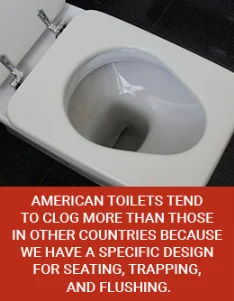
Some of the other common reasons that a toilet will clog include:
- A low-flow design that isn’t flushed soon enough. These designs require more flushing because they can handle less waste.
- Hard water deposits can build up at the bottom of your bowl and generate clogs.
- The S-shaped trap that runs from your bowl to the drain line is one area of traps because it is designed to prevent clogs in your sewer lines. Large objects can collect here — from toys to wipes — and cause a backup. A clog that can be removed with a plunger is usually formed at the trap.
The drain that connects most homes to the main sewer line is just four inches wide, meaning that your clogging items don’t have a lot of leeway to make it away safely. Checking these areas a few times a year and calling a plumber when you have a concern is the best plan for strong toilet preventative maintenance.
How to Dissolve Toilet Paper in a Sewer Line
If you can’t clear up a toilet paper clog with a plunger, you can try a closet auger. It’s a long piece of wire with hooks on one end. Insert the hooked end into the toilet to break up the mass of toilet paper and debris. Sometimes this is enough to resolve a toilet paper clog in a sewer line.
If these tools don’t dissolve the toilet paper clog in your sewer line, call Mr. Rooter® Plumbing today for fast, reliable help.
Wet Wipes Are a Wet Clog
Sewer clogs are on the rise and wet wipes are a major culprit, even those with the “flushable” branding.
Wet wipes have become very popular but they don’t play well with an aging infrastructure. Many older neighborhoods, like those in the northeastern United States, are finding themselves at risk for shelling out big bucks to clear clogs related to wet wipes.
Older systems that rely on gravity as their main method of moving sewage actually tend to run smoothly and deliver waste quickly from your home to the sewage pump. Unfortunately, some of the tests used to determine if an object is “flushable” fail to match these standard circumstances. Such tests will often agitate and tear up materials more than gravity systems and can provide up to three hours for materials to break down, but real-world situations may take closer to a couple of minutes.
In 2013, the problem got so bad in Bemus Point, N.Y., that municipality leaders had to resort to setting traps in sewers to identify which homes were flushing these wipes. The locality then mailed them letters asking that wipes no longer be flushed.
While wet wipes may not be the most dangerous items for your specific toilet to flush, they can harm your sewer line and those of your neighbors. This damage can lead to major problems and backups that can make your whole street smell worse than you’ve ever imagined.
Q-Tips Are for Ears, Not Toilets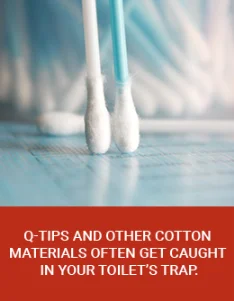
Cotton swabs and Q-tips are commonly tossed into the toilet instead of the trash, but this can lead to severe blockages in your system. Q-tips and other cotton materials often get caught in your toilet’s trap and move across the grating.
They also can get stuck in the flange of your toilet where it meets the floor, creating a blockage directly under your seat.
When Q-tips build up, you’re sitting on a ticking time bomb that will lead to paper and waste coming back up and overflowing. The mess created by the Q-Tips is unfortunately located as close to you and your floor as possible.
Cotton balls and swabs cause much of the same damage. You might be tempted to think that cotton will degrade and not be an issue, but that decomposition takes a while. That means you’ve got plenty of time for cotton to stretch out and grab everything that comes floating by on its way out of your home.
Keeping a trashcan nearby and making a point to toss these in it is a great step in your toilet preventative maintenance.
Diapers Don’t Pamper Your Pipes
Lots of people try to flush diapers down the toilet. Some diapers brands have inserts that can be removed and this may have contributed to the increasing trend of putting the soiled nappies down the drain.
Never flush a diaper. Many of the “flushable” inserts can also cause problems with your plumbing.
The main role of a diaper is to absorb liquid, which makes the diaper bigger and will dry out pockets in your sewer line. Diapers are able to create clogs anywhere down the line, from your toilet and outgoing line to sewer connections and sewer plants.
The diaper problem has become so significant that you can now purchase pre-made warning signs that specifically reference disposable diapers. Diapers are designed to be discarded in the trash, so please do that and remember that a toilet is never a trashcan.
Dental Floss Does Damage
This one is admittedly weird: Dental floss seems so small and malleable that you’d believe it could be flushed, but it comes with a big risk.
Dental floss’s small size and flexibility allow it to get caught up on just about anything or wrap around itself and catch other items in a ball larger than you’d expect. Sharp bends and pipe burrs are top areas for a clog and dental floss is able to take advantage of each and every one.
You might have noticed that dental floss can be pretty strong. It’s also non-biodegradable. That means it’ll catch or cut through any of the decomposing materials while maintaining its own strong structure. In your pipes, dental floss can create the perfect storm for a clog that you’ll have to see, smell and pay to remove.
Band Aids Don’t Degrade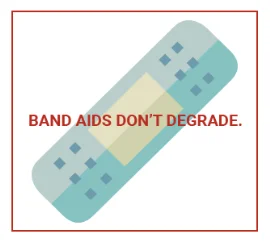
The band-aids you’ve got in the first aid kit and medicine cabinet should never get flushed because they won’t degrade. Band-aids have sticky, plastic parts that are prone to clogging up your sewer lines. Even band-aids with cloth parts will generate big clogs.
Band-aids alone typically aren’t common enough or large enough to generate a big clog, but they easily add to other materials when a clog is starting and can turn a small concern into a major problem. Though not a major issue for most, band-aids are still high on the list of what not to flush in your home.
Grease, Fats and Oils
Not many people cook in the bathroom but you might be surprised at how many people dispose of fats, greases, oils and other cooking waste down the toilet. No matter what drain you’re using, cooking fats should never go down it.
When these waste products hit your plumbing pipes, they’ll start to cool and turn from a liquid into a sludgy solid that congeals and catches everything that passes by. Essentially they’ll become a wax that everything is caught in. Your favorite restaurants have special grease disposal units and traps designed to prevent the major problems and clogs that come from grease in drains.
Like the other things on our list, fats should be scraped into the trash to be thrown out. A toilet preventative maintenance plan should look like your plan for other drains in your home. Keep things clean and don’t give in to the temptation for shortcuts.
When it comes to grease, down the drain is a big pain.
Your Medicine Doesn’t Flush
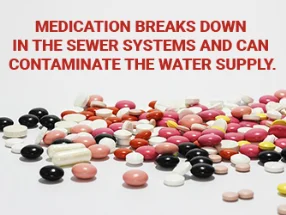
Medicine needs to be disposed of properly — not flushed down the toilet.
Medicine won’t cause a clog in your toilet or sewer but it can cause harm to the general population. Medication breaks down in the sewer systems and can contaminate the water supply.
Scientists are still studying the harm that a contaminated water supply can cause to both people and animals. Currently, there is no clear decision. The Food and Drug Administration suggests flushing medication that has the potential to be abused, but states and local governments have passed stricter regulations to keep these out of your plumbing.
“Nonetheless, FDA does not want to add drug residues into water systems unnecessarily,” said Jim Hunter, R.Ph., M.P.H., an FDA pharmacist. Wrap up your medicine, black out all of the personal details on the bottles and hide them in the trash.
Tampons and Sanitary Napkins
One of the most common reasons for a home clog is the flushing of a tampon or a sanitary napkin. The cotton in these items can easily snag and grab on just about anything — like the Q-tips noted earlier — but these materials tend to be larger and lead to clogs faster.
Cotton won’t break down in water and does major damage to septic systems because it can continually release fibrous tissue. The fibrous tissue can harm all kinds of machinery and create clogs everywhere down the line. Like many other materials that won’t decompose, cotton must be physically removed from the waste stream by the workers processing the waste, who must then send the cotton to a landfill.
Many people know that tampons are among what not to put down the toilet, but we still see clogs and other problems every year involving these sanitary devices.
Stop Flushing Kitty Litter
Cat litter often lives in the bathroom so the whole family can do its business in the same place. Unfortunately, that means it can often wind up in the toilet — an event that’s quickly followed by a call to a plumber to handle a clog or backup.
Litter is one of the most important things on the “what not to put down the toilet” list. Kitty litter includes more than just your cat’s waste. It also has clay and sand, which are extremely troublesome for any plumbing system. The clay and silica clumping litters are designed to absorb moisture and create clumps, which turn into large clogs almost immediately once they enter your pipes.
A major health concern is also associated with flushing cat litter. Cat feces often contain the toxoplasma gondii parasite that is linked to birth defects in humans — this is the reason that pregnant women are warned against cleaning the litter box.
Sewage systems can’t always kill this parasite, so it can make its way into the ocean or back into some water systems that people interact with. In the ocean, the parasite is often eaten by crabs and starfish — food sources for people and cute little animals like the sea otter. About 17 percent of the sea otters that die each year are believed to be killed by this parasite.
Technology Is a Growing Problem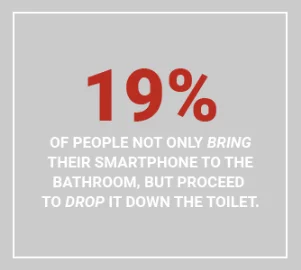
What costs more than five hundred dollars and doesn’t know how to swim? Your smartphone!
One study has found that 19 percent of people not only bring their smartphone to the bathroom but proceed to drop it down the toilet. While most people won’t try to flush these devices downstream, some phones and tablets do have the potential to get stuck in your toilet bowl.
If children are allowed to bring electronics into the bathroom, there’s a good chance you may hear one of the worst “uh-oh”s around as the expensive and delicate item sinks like a stone. Save yourself a major headache and a lot of money by keeping devices of all kinds out of the bathroom.
Toilet Preventative Maintenance: When In Doubt, Keep It Out
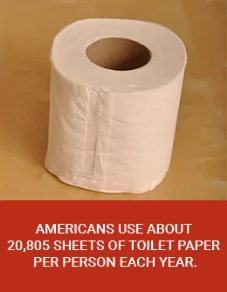
Discussing what not to put down the toilet can give you a very big list, because just about everything falls into the “what not to flush” list. Ultimately, your toilet and sewer system were designed to handle just three things: urine, solid waste and toilet paper. Some newer toilets may be able to handle a wider range of papers and wipes, but that doesn’t mean your home’s plumbing can.
Older homes are at a major risk because they have older plumbing. Any of the items on the “no” list can end up generating a clog at some point in your system such as at pipe joints or areas where roots have intruded.
Americans use about 20,805 sheets of toilet paper per person each year, making the product a two-hundred-billion-dollar industry. Plenty of waste is going down your toilet, so it’s time to start thinking about all of the items in our sewers.
Testing What Not to Put Down the Toilet
There are many different flush tests that you can try at home to learn what is and what isn’t safe. Thankfully, none of these will put your toilet at risk. Plus, they can be a great tool to show kids why it is important to only flush a few items down the drain.
One of the most common “flushability” tests involves two large bowls of water. Place some toilet paper in your first bowl and then place other materials — such as sanitary napkins, Q-tips, cotton swabs or any other items in our list — in the second bowl.
Swish the two bowls around in the water and then let them sit for about an hour. Have everyone come back and look at the materials before swishing them around again.
At the end of the second swishing, compared the two bowls. The toilet paper should be almost completely dissolved but your other materials will remain largely whole. The less that material breaks up in your experiment, the less it will dissolve in your plumbing.
The final piece of important work is to show everyone what to do with what’s in the bowl. Toilet paper can be flushed, while the other materials need to be placed in a garbage bag and thrown away in a trashcan. Repeat this with everything you can from keys and paper towels to hard devices (maybe an old smartphone) to show everyone what can and what can’t be flushed down.
If your children need a little help remembering, it all comes down to three Ps: pee, poo and paper.
Share the News About What Not to Flush
The biggest problem is that your toilet can handle a lot. Balloons, hot dogs, golf balls, orange peels and more can all make it down with a full flush. Lots of strange items will fit and flush, and toilets are now touting strange capabilities because it can be fun to test this out in a safe, laboratory environment. However, flushing these items and the others we’ve listed above can do significant harm to your home.
Hair, eggs, paper towels and many other strange items have been found in sewer systems over the years. Just because it can flush, doesn’t mean it should. So, never treat your toilet like a trashcan and always play it safe with what you flush. If you ever have any doubt, bag the item in question and throw it out with the trash.
If you’ve come across a clog that you just can’t get rid of or if you have flushed a lot of these items and think a clog may be looming in your future, contact Mr. Rooter Plumbing of Greater Syracuse for a checkup to keep everything flushing smoothly.
